Menu
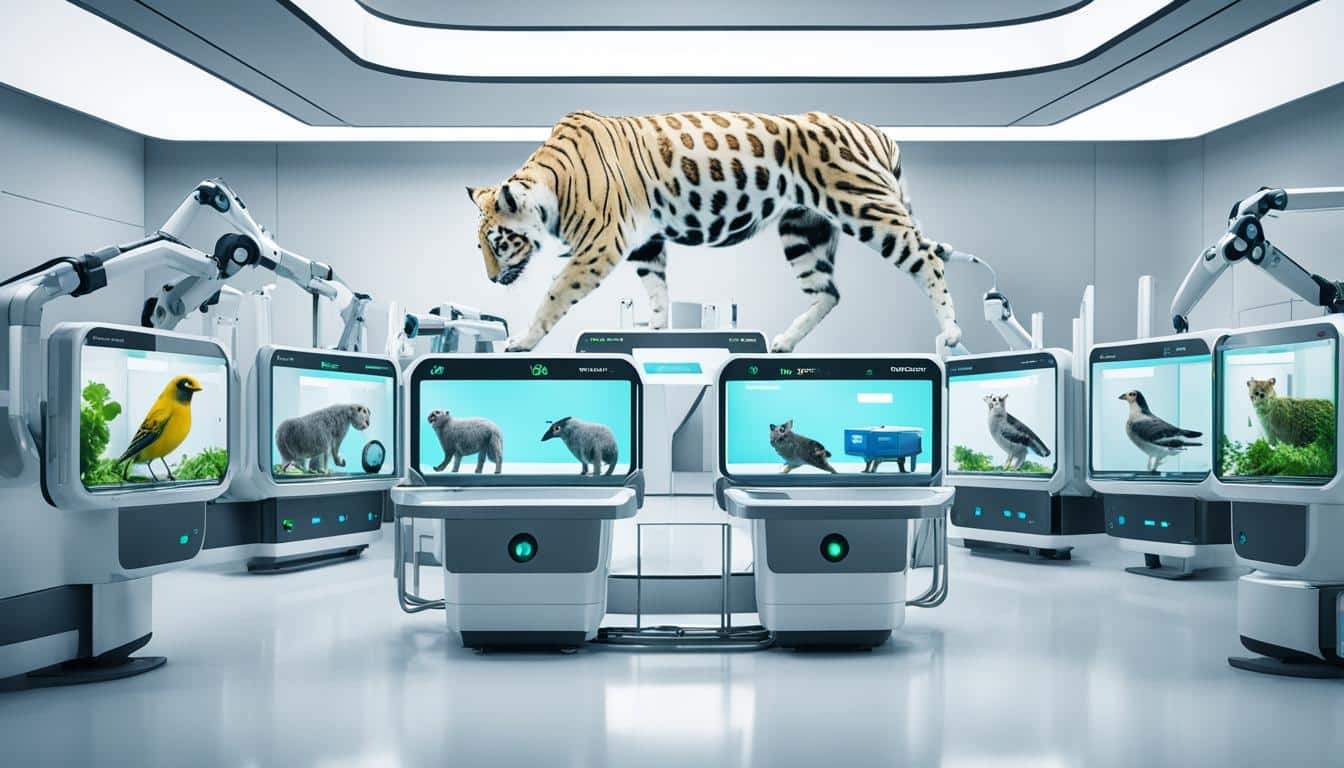
In 2024, AI-driven tools are changing the game in veterinary medicine. They can quickly and accurately spot diseases, beating old methods. The result is better and faster care for pets. Companies are now making pet food tailored to each animal’s needs. They are also clear about what’s in commercial pet foods. This new wave of tech brings a caring boost to looking after animals.
There are new foods based on the latest in nutrition. These prove that special diets are truly beneficial. Products like smart collars let pet owners track their pet’s health constantly. They catch signs of health issues early, which makes pets healthier.
Owners can now do some basic checks on their pets at home. This offers a big help for keeping pets healthy without extra vet visits. Plus, virtual vet services are now a thing. They offer advice over the internet and help in emergencies. This makes pet care easier and less stressful for pet parents.
Projects like IMAGEN are uniting experts to push tech for pet welfare. They aim to use sensors and AI to understand what animals need. This work focuses on farm animals. The goal is to improve their health, well-being, and the environment through better tech.
The historical development of animal welfare technology has come a long way. Dairy farming shifted from hand to mechanised milking over 150 years. In the last 30 years, we’ve seen milking robots, wearable sensors, and more for better progress in animal care innovation.
Across the United States and the European Union, people have been adding nearly 1 million dogs each year. This shows a big increase in pet ownership worldwide. This growth has made it important to have new ways to take care of animals.
Today, technology helps veterinarians find answers to rare illnesses across borders. It allows for better care for animals with unusual health problems.
There are also digital systems helping farmers track how their animals are treated and their products reach stores. This progress in animal care innovation lets farmers spot the first sick animal in a big group quickly.
Now, we have tools that check animal health in real time. These tools can find early signs of sickness and help stop diseases before they spread. This shows the historical development of animal welfare technology improving with personalised care.
Veterinary diagnostics are much advanced now. Digital systems can do more than just diagnose. They help prevent diseases by spotting early warnings and finding risk patterns. This is a big step in caring for animals better.
Digital tools are transforming animal health by connecting monitoring and diagnosis. They can predict sickness and detect it early. With sound detection, genomic sequencing, and more, they can save animals from dangerous illnesses.
The historical development of animal welfare technology has led to big improvements in care. It highlights the need for ongoing innovation in this essential field.
Technology is changing the way we look after animals. AI tools are now helping vets diagnose pets better and faster. They use special computer programs to improve the accuracy of medical tests.
These AI systems can look at lots of medical information quickly. They help vets find out what’s wrong with an animal more accurately and in less time. This is shown in how AI can read medical images better.
AI is also great at managing medicine supplies. It keeps track of when medicines expire. This means there’s less waste and vets don’t run out of important medicines.
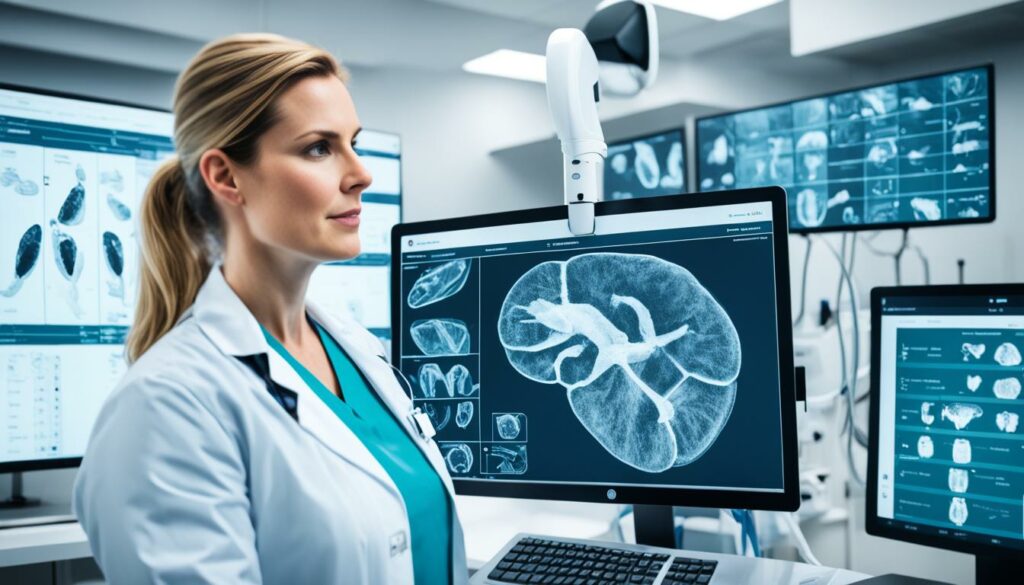
Royal Canin uses AI to suggest the best food for pets. When they work with vets, they can recommend very specific diets. Idexx Labs uses AI for more accurate and fast test results.
A study from the University of California, Davis shows how AI can improve care for each animal. It uses a lot of different information to create treatment plans that work best for each pet.
More and more vets are using AI tools. 83.8% of them know about AI. And almost 40% plan to use AI in their work soon.
Companies are investing in AI for animal health, like PetPace and ImprImed. They think AI can make tests and treatments better for pets. This means vets can focus on giving more care and time to animals and their owners.
Pet health devices are changing the way we care for animals. Devices such as smart collars keep track of a pet’s health all the time. This means owners can know right away if their pet needs help. It’s a game-changer for spotting health problems early.
Smart pet collars and wearables are leading a new wave of animal care. Brands like Felcana and Whistle track things like heart rate and activity. They help pet parents and vets understand their pet’s health better.
Wearables bring big advantages like alerting owners to health issues fast. For example, PetPace can notify you if something seems off in your pet’s health. They help with early problem detection.
But, these devices have to worry about battery life and accurate data. Fixing these issues is vital for them to work smoothly.
| Device | Key Features | Advantages |
|---|---|---|
| FitBark | Activity levels, behaviour changes | Aids in early health issue detection |
| Felcana | Heart rate, respiratory rate | Detects early signs of diseases |
| Whistle | Activity, rest, calories burned | Facilitates health discussions with vets |
| LinkAKC | 24/7 GPS tracking, symptom analysis, LED flashlight | Comprehensive safety and health monitoring |
Alpha Vet Tech’s WirelessZoo™ is a top example of using new tech for pet health. Smart collars and apps help track pets’ health in many ways. It’s a big step towards making sure our pets are as healthy as they can be.
Pet owners today have the chance to use pet health assessment tech at home. These domiciliary vet care tools make it simpler to check and look after their pet’s health. This cuts down on too many trips to the vet.
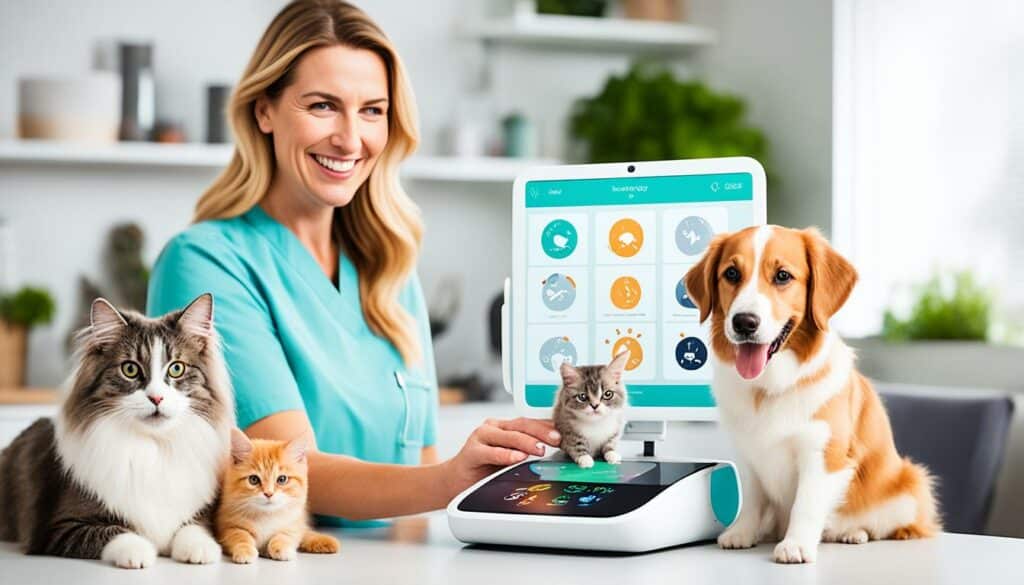
Covetrus is one standout. It’s an online vet pharmacy with a wide range of over 10,000 items. They include drugs, food, and even chemotherapeutic medicine. Covetrus is licensed in every state and has Vet-VIPPS certification. It provides quality drugs at good prices. Also, it offers custom-made drugs through its compounding services.
DIY diagnostics for pet health like Oncotect offer cancer tests for dogs at home. These tests need a simple urine sample. They can spot common cancers early, like melanoma and lymphoma. Using these tests is easy for pets. Oncotect’s tests are praised for their accuracy. They help know if further, more invasive tests are needed. This can save time and money for pet owners.
MySimplePetLab (MSPL) has rapid, easy-to-use testing for common pet health issues. It covers problems like diabetes, skin troubles, and ear infections. MSPL also has blood glucose monitors. They are great for pets with diabetes. With Merck Animal Health’s Pet Diabetes Tracker, owners can keep a detailed health record. Apps like FitBark Dog GPS & Health and RVC Pet Diabetes make tracking health easy. This improves how pet health is managed.
The pet health assessment tech and domiciliary vet care tools bring many DIY health care options to pet owners. These tools offer ways to take care of pets at home. They help improve the bond between owners and their pets. And, they give a better understanding of their pet’s health.
tailored pet nutrition is now a big deal in pet care. It’s all about the latest nutritional research. This helps us make diets that meet each pet’s exact needs. This means healthier and happier pets.
We’re learning more about what pets need in their diets. Thanks to new tech, we can create personalised nutrition plans. These plans make sure pets get the right nutrients for a healthy life.
Specialist diets can really change a pet’s health. Better feeds, probiotics, and prebiotics are being used. This improves how pets absorb nutrients and their gut health.
Including stuff like enzymes and antioxidants in food also helps. It makes pets healthier and more active. This is great for their overall health.
People often think commercial pet foods are bad. But thanks to new research by companies like ADM, we know better. These companies follow strict rules to make safe and nutritious foods.
They’ve been in the market for years, serving pets around the world. They care about safety and nutrition. So, pet owners can feel good about what they feed their pets.
The pet food industry is changing for the better. It’s moving towards feeds that are good for the planet. People want to know where their pet’s food comes from. They’re also interested in new protein sources. This shows how the industry cares about making pet food that’s both good for pets and the Earth.
The world of pet care is changing a lot. Now, with virtual veterinary services, pet owners can see a vet without leaving home. This new way of looking after pets uses technology to talk to a vet from afar.
Telemedicine is making it easier for pet owners to get advice from a vet. This is especially useful as the number of pets grows worldwide. Now, with technology, vet consultations and diagnoses can happen over the internet.
Remote vet consultations bring many benefits. They cut down on the stress of going to a clinic, for pets and their owners. Quick access to vet advice can help in emergency situations.
This technology is a big help for people living far from pet clinics. It makes getting care easier without needing to travel.
Real stories show how useful telemedicine can be in emergencies. When a fast response is needed, remote consultations can save the day. These examples highlight the importance of quick advice, avoiding delays in caring for pets.
This table shows some of the important parts of telemedicine in vet practices today:
| Aspect | Description | Advancements |
|---|---|---|
| Accessibility | Remote consultations for pet owners | Enhanced through digital platforms |
| Stress Reduction | Eliminates the need for clinic visits | Improves pet and owner experience |
| Timeliness | Immediate access to veterinary advice | Facilitates quicker responses in emergencies |
| Cost Efficiency | Reduces costs associated with travel and in-clinic visits | Makes veterinary care more affordable |
| Specialised Care | Connects general veterinarians with specialists | Provides expert insights and recommendations |
Digital technologies have transformed veterinary care. They use cloud computing and big data to help with animal health. Veterinary cloud software plays a big part by storing and analysing lots of data. This helps improve how we take care of animals.
Wireless and mobile tech have been key in monitoring animal health and fighting diseases. They give instant updates that help veterinary teams a lot.
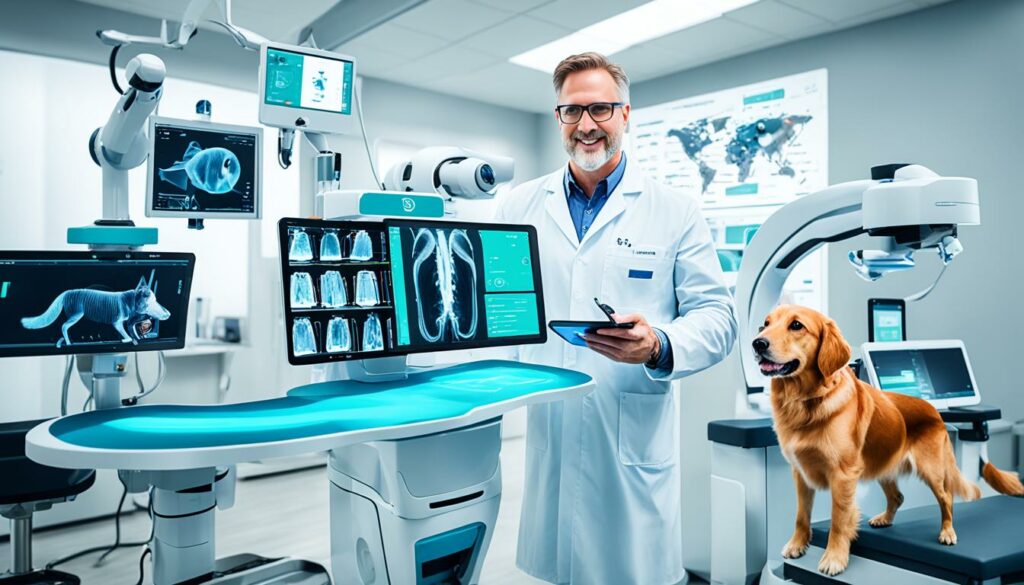
Cloud computing helps veterinary practices organise and secure their data better. It allows easy sharing of patient info and supports high-tech analytics. The One Health Initiative uses these tools to join up human, animal, and environmental health data. This helps keep diseases under control.
Using big data is changing the game in veterinary medicine. It helps vets see patterns, predict diseases, and create treatments that fit each animal. Tools look at health records, genetic information, and where animals live to make diagnosis better and decisions more informed.
For example, predictive tools spot which animals might get sick first. This helps prevent diseases. It also helps make medicines better by using data to improve how they’re made.
Veterinary care has to keep up with these digital changes. Moving with the tech and training staff to use it well is vital. This will make veterinary care stronger and more efficient in the end.
The world’s population is growing fast, and so is the need for food. This puts a lot of pressure on our farms. Farming sustainably, especially with livestock, is key. It helps us meet our needs today while keeping our planet healthy for the future.
In South Korea, there’s too much animal waste for the farms to handle. This overload causes pollution. The country is working hard to cut greenhouse gases by 2030. Their aim is to reduce emissions by up to 30% in the next decade.
“Managing agriculture in a way that protects the environment, supports natural resources, and maximises the utilisation of non-renewable resources is key.” – U.S. Department of Agriculture (USDA)
Smart Farm is introducing new tech to make farming more sustainable. They use sensors and data to watch over animals and the environment. This helps farm managers solve problems quickly, lessening harm to nature. Animals get personalised care, which is good for both them and the planet.
The future of farming animals sustainably looks bright. With the help of Smart Farms, farming is becoming more advanced. Techniques like precision farming and growing crops in skyscrapers (vertical farming) are on the rise. Such practices make sure animals are well looked after, improving the environment too.
| Country | Year | Nitrogen Balance (kg/ha) | Phosphorus Balance (kg/ha) |
|---|---|---|---|
| R.O.K | 2020 | 230 | 46 |
| USA | 2020 | 150 | 30 |
With these new technologies and ways of farming, we are making a better world. This new system is good for the animals and for us. It’s a win-win for the planet.
Activity trackers for pets are becoming more popular. They let us learn a lot about our pets’ behaviours. This information is very important. It helps us understand their daily routines and health needs better.
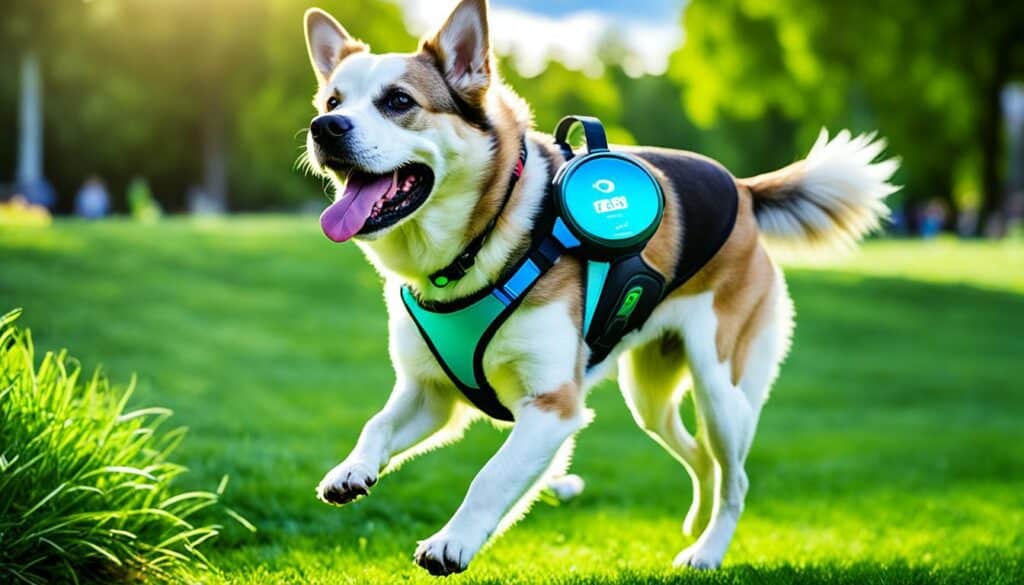
These wearable devices use sensors to watch how much your pet moves, their heart rate, and sleep. When placed on a pet’s collar, they send activity alerts in real-time to the owner. According to a study by Ladha and Hoffman in 2018, these gadgets are quite precise. For example, they can tell when dogs are resting. This shows how far we’ve come in understanding our pets with technology.
Behaviour data from these devices is a game-changer for pet health. It allows us to react fast if we notice something unusual about our pets’ behaviours. An example is the PetPace Activity Monitor. A study by Belda and others in 2018 showed it works well to keep an eye on how active pets are. Knowing our pets’ habits lets us care for them better.
The future of pet activity tracking looks bright. Studies predict the market will earn around USD 6.88 billion by 2030, with a 14.3% growth each year. This shows more and more people are interested in using tech to improve their pets’ lives. Companies like PetPace and WagTag are leading the innovation for better pet healthcare.
| Aspect | Details |
|---|---|
| Market Value (2022) | USD 2.7 billion |
| Forecasted Market Value (2030) | USD 6.88 billion |
| Growth Rate | 14.3% CAGR |
| Key Players | PetPace, WagTag |
| Key Insights | Understanding pets through wearables, behavioural insights from pet tech |
Technology is changing the way we look after animals, leading to better health results. It focuses on spotting issues early, stopping diseases, and finding problems before they start. This approach means we need to use treatments that fight illnesses less.
Farming has seen big changes in the last 150 years. Now, we have smart tools like milking robots and wearable tech. These can tell us a lot about an animal’s health by tracking their actions and needs.
Digital tools have become vital for caring for animals. They can predict health changes and help vets act in advance. This makes a big difference in keeping animals healthy.
AI is making health checks better, too. It can quickly find out if pets have parasites using special systems. Plus, there are big databases that help vets make smarter choices. This means everyone is part of a big team working to keep animals healthy.
Looking at an animal’s genes also tells us a lot about their health. We can know about potential illnesses early, and experts use new tech to check on animals’ health 24/7. This means we can help quickly if there’s a problem.
There are more pet dogs joining families year by year in many places. Quick and cheap health checks are really needed because of this. Thanks to new tests and gadgets, pet parents don’t have to wait long for information about their pets’ health.
The following table encapsulates key technologies and their contributions to proactive health tech for animals:
| Technology | Contribution |
|---|---|
| Wearable Sensors | Track vital signs and behavioural data |
| AI Diagnostics | Identify parasites and health issues swiftly |
| Genomic Sequencing | Reveal genetic predispositions |
| Big Data Systems | Support informed veterinary decisions |
| Thermal Imaging | Monitor temperature changes |
| Microfluidic Devices | Rapid, in-house diagnostic results |
By using these new technologies, we can do a lot to keep our animals healthy. We can act fast and make life better for all animals we care for.
The Internet of Things (IoT) is changing how we look after animals. It lets us use smart devices to keep track of their health instantly. This new way helps us take better care of them.
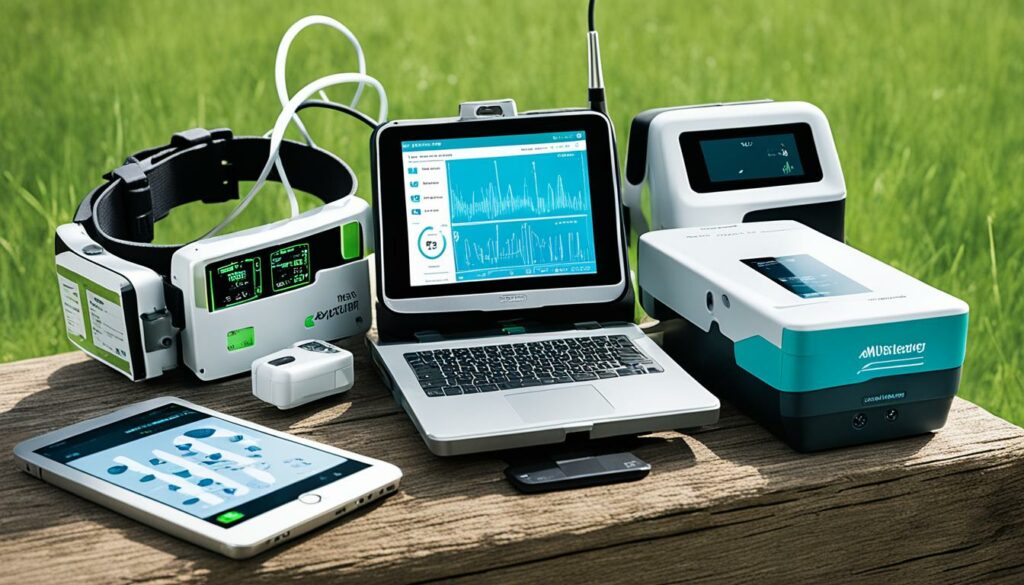
IoT is very important in today’s vet care. Devices like smart collars and GPS trackers help us watch over animals closely. They give us updates on their health and location. This helps us manage them better, making their lives improve.
| Market Statistics | Details |
|---|---|
| Sensors Market Share (2016) | 51% |
| Anticipated Market Growth (2022-2029) | 12.1% |
| Expected Market Value (2029) | USD 11.18 billion |
Connected devices are a big plus for pet owners. They help keep pets healthy by giving owners important info immediately. This means spotting health problems early and fewer sudden vet trips. Plus, they make vet visits smoother and more effective.
More than 200 tech experts are working on IoT apps to help manage farm animals. They want to make farming more efficient and caring. This way, farming will be better for animals and the environment.
Animal healthcare has taken big steps forward lately. Thanks to 212 experts, new tech is in use. It helps diagnose, prevent, and treat animal illnesses. These improvements are leading to exciting changes in animal health.
New technologies in animal care are making huge differences. By changing the genes of animals, we can make them healthier or produce more milk. This is making a big impact on farm animals around the world.
Special computer tools can also help understand diseases better. They find how genes work together. Adding good bacteria to animal food makes their digestion better. It’s just another way tech is helping animals lead healthier lives.
Vets have seen great results with new treatments. In chickens, special molecules help with fatty liver disease. They are like tiny doctors for the animals.
Removing certain drugs from cow diets has led to better alternatives. Now, farmers can use special food additives for healthier cows that produce more milk. A common mineral and extra vitamins have also shown surprising benefits in cows.
The table below shows some amazing successes with these new animal treatments:
| Case Study | Details | Outcome |
|---|---|---|
| Genome Editing in Livestock | Accurate genome alterations using programmable DNA nucleases. | Enhanced milk production and disease resistance. |
| MicroRNAs in Poultry | Micro-regulators of gene expression for addressing fatty liver syndrome. | Improved health and performance of hens. |
| Probiotic Feed Supplements | Use of probiotics to reduce disease and improve livestock productivity. | Healthier animals with higher productivity and reduced harmful emissions. |
| Lactic Acid Bacteria Mixture | Combination with molasses for better rice straw digestibility and rumen microbial colonisation. | Increased efficiency in animal feed consumption. |
These stories show how much new animal treatments are helping. They are making animals healthier and more productive. They are also showing us new ways to provide care for our animal friends.
We’re now exploring animal welfare tech more than ever. It’s key to focus on ethics. Ethical use ensures animals are treated well even with new tech. The ethics around things like genetic engineering are under the spotlight. It’s vital we think about the right and wrong in these new advancements.
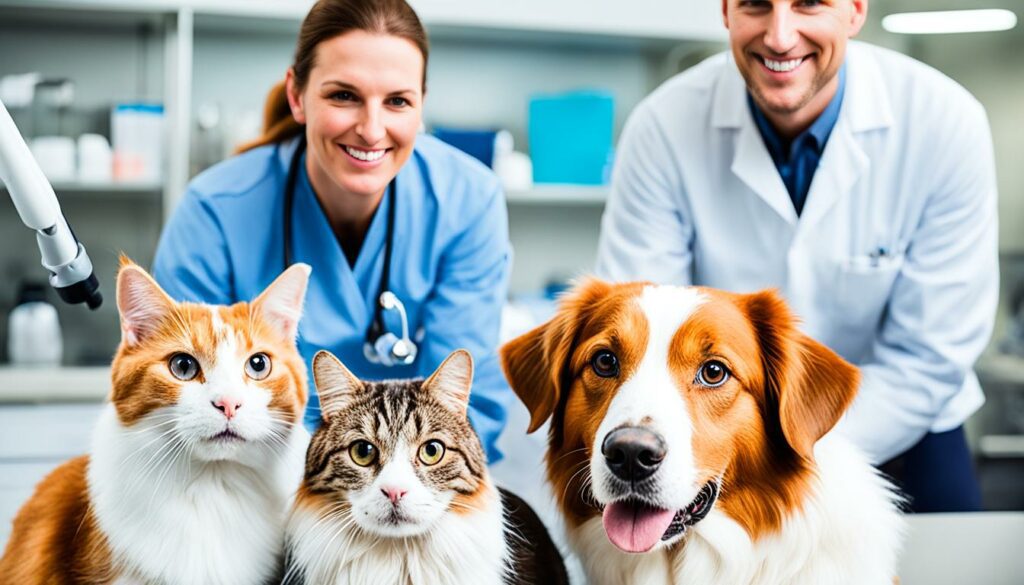
Genetic engineering in animals is growing. This brings up many ethical issues. Terms like ‘genetically modified’ and ‘transgenic’ are used. Guidelines from the Canadian Council on Animal Care cover these, calling them ‘genetically engineered’.
Veterinary tech hits ethical snags, like the ethics of procedures. It involves many animals and can have hidden welfare problems. The balance between good outcomes and risks forces us to think deeply. For example, the first cloned cat “CC” appeared in 2002, and then “Snuppy” the dog was cloned.
In farming, genetic engineering boosts productivity. It aims to make food healthier and protect the environment. This includes pigs with more omega-3 and goats making human enzymes. But we must decide the limits to these changes.
Using animals in research adds another layer of ethical debate. From 2017 to 2021, studies have raised ethical concerns. The goal is to reduce harm and find alternatives. Animals like genetically modified mice help in health research. This shows the challenge in finding a good balance.
We must weigh the benefits of humane technology applications against potential ethical pitfalls to ensure animal welfare remains the priority within technological innovations.
People’s stories about animal welfare tech show us its real-life impact. They talk about how it helps the animals and makes owners happier. Through their stories, we learn about the good and the bad of using this technology.
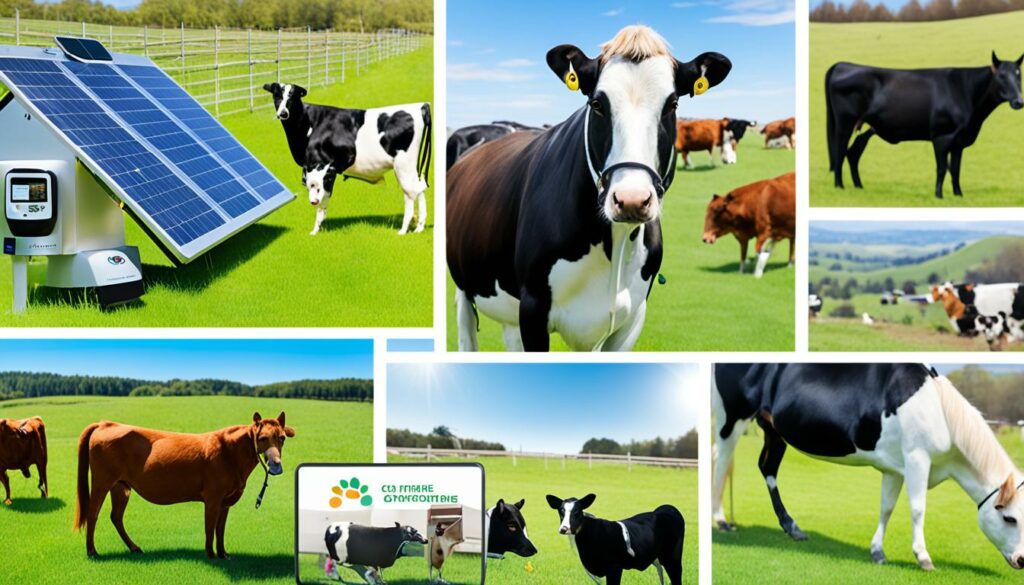
Pet lovers and animal experts love these new tools. They are happy to share how much better things are with them. The RSPCA in the UK, for example, is very pleased with Altia’s Capture software. With this tool, they could look into 57,000 cases of animal cruelty in 2020 much faster. It made their work more accurate, saved money, and used fewer resources.
The officers who use Capture are more sure of themselves and their work is easier. This is all because the tool is easy to use and helps them do better. Altia wants to help the RSPCA catch those who hurt animals. They do this by making sure their technology is top-notch.
Veterinary tech in places like the Dutch slaughterhouses has made a big difference. These places now use the AI4Animals system to take care of animals better. It watches videos all day to pick up on risk and stress to animals. A big company like Vion finds this very helpful for keeping their animals safe and happy.
Customers using this tech are also very happy. The AI4Animals system makes their work easier and saves time. It looks out for the animals, spotting things like too much stress. This system is very smart. It works really well with other tech, making everything run smoothly while helping animals more.
| Metric | Capture Software | AI4Animals System |
|---|---|---|
| Implementation Scale | Developed with RSPCA officers | Deployed in major slaughterhouses in the Netherlands |
| Cost Efficiency | Saved thousands on paper-based resources | Optimised resource use and animal welfare |
| User Feedback | Enhanced officer satisfaction and confidence | Improved staff awareness and response to welfare risks |
| Operational Impact | Boosted investigation capacity | Increased monitoring and incident detection |
Pet owners and experts agree. Tech for animal welfare is changing many lives for the better. These new tools are making it easier to take great care of our animal friends.
The world of animal welfare is changing fast because of new trends in technology. These changes will help look after animals’ health better, in a more planned and individual way.
Recent studies have brought big progress. They have improved how we diagnose, prevent, control, and treat diseases in animals.
Looking ahead, knowing what animals eat and the vaccines they get will be key. Things like probiotics and prebiotics are very important for animal health. And, high-tech vaccines that can resist heat help animals in different weather conditions to not get sick.
One cool innovation is using conveyor belts to vaccinate baby chicks. This method is fast and respects their welfare. Along with mRNA vaccines, these tools show a new way to stop diseases from spreading.
“The integration of these technologies points towards a future where animal health care is not only more effective but also more compassionate and sustainable.”
Let’s now look at some numbers to fully grasp these trends:
| Research Contributions | Breakthroughs |
|---|---|
| 25 original research articles | Successful use of heat-resistant vaccines |
| 5 review articles | Positive outcomes with mRNA vaccines |
| 3 systematic review articles | Genome editing for livestock improvement |
| 1 method article | Introduction of conveyor belt vaccination |
These new trends in animal health technology are transforming how we care for animals. By using predictive models and the latest technology, we’re making big steps forward. The future will bring lots of new and better ways to help our animal friends.
Exploring animal welfare technology shows it can really boost how we care for animals. Smart farming tech helps find health issues in farm animals early. This means less medication and fewer deaths, while their health improves. Despite concerns about intensive farming, smart sensors and big data make dairy farming better, especially for spotting lameness early.
Precision farming lets us watch over animals individually with special tags and trackers. It can even use cameras to spot diseases early. But, people can’t agree on what ‘animal welfare’ really means. So, we use different signs like lifespan, how many babies they have, their behaviour, and physical changes. These things show us how complex it is to make sure animals are treated well in smart farming.
Zoos are also getting better at looking after their animals thanks to guidance from groups like EAZA, WAZA, and AZA. They give out detailed advice on how to care for animals in zoos. Research on zoo animals, like elephants and giraffes, shows that looking at their behaviour can help us know how they really feel.
In the end, animal welfare tech proves how important it is to keep using new inventions to look after animals. These new tools not only help us take better care but also make us more caring toward animals. Looking ahead, we see a future where animals’ lives are made better through new tech that keeps getting better.
Animal care tech has come a long way. It started with basic tools and has now grown to address specific issues. Modern solutions like AI for diagnosis and real-time health checks have really boosted animal care.
AI helps vets make faster, more accurate diagnoses. Tools from Royal Canin and Idexx use tech to spot health issues quickly. At the University of California, Davis, AI is seen as key to better, more personal pet care.
Devices like smart collars track pets’ health all the time. They spot problems early, helping vets act fast. The WirelessZoo™ by Alpha Vet Tech uses the latest tech to give owners and vets useful health data.
At-home tools let pet owners check their pets’ health easily. This helps with regular health checks. It also strengthens the bond between pets and their owners by deepening understanding.
Tailored diets are great for pets’ health. They address specific needs and boost energy. These diets also take on common diet myths, fighting pet health issues head-on.
Remote vet care takes away the stress of visiting a clinic. It’s quick and easy, avoiding long waits. Many people find it especially useful in emergencies.
Using data in vet practices makes care better and more efficient. Big data helps vets make smarter decisions. It leads to improved health outcomes for pets and smoother operations for clinics.
Sustainability is a must for feeding a growing world. Smart Farm’s tech takes care of animals individually while being eco-friendly. It sets a new standard for farming that’s good for animals, people, and the planet.
Wearables show how active and healthy pets are. They help vets and owners find patterns in pets’ behaviours and health. This leads to better, proactive care for animals.
Tech catches problems early, before they get serious. This kind of care means a better life for animals. It focuses on stopping illnesses before they start.
The IoT connects devices to monitor pets’ health instantly. This helps with quick, easy access to pet health info, making care simple for owners. It’s changing how we look after our pets.
New tech is improving traditional animal care. It’s making treatments more effective. These stories show how tech is changing the way we care for animals, making a real difference.
Using tech on animals must be done carefully. We need to make sure tech helps animals in a good way. It’s important that we think about the ethical side of new technology in animal care.
What pet owners and experts say about new tech matters. Their views show how these innovations change pet care. They help us understand how new tech can make a difference in looking after pets.
The future of animal care tech is exciting. It will be more integrated, focusing on keeping pets healthy and happy. These new approaches are set to redefine how we care for animals, promising even better care.